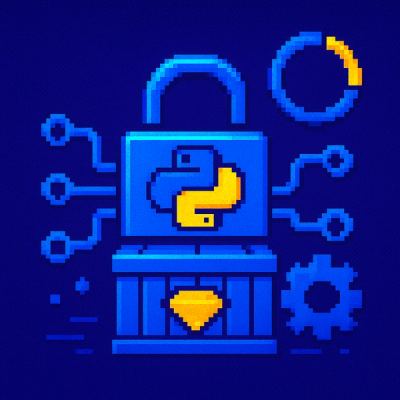
Security News
Another Round of TEA Protocol Spam Floods npm, But It’s Not a Worm
Recent coverage mislabels the latest TEA protocol spam as a worm. Here’s what’s actually happening.
Python bindings for the JGraphT graph library.
The JGraphT is a free Java class library that provides mathematical graph-theory objects and algorithms. It contains very efficient and generic graph data-structures along with a sizeable collection of sophisticated algorithms. The library is written with stability, performance and interoperability in mind. It includes algorithms encountered in diverse application domains such as path planning, routing, network analysis, combinatorial optimization, computational biology, and others.
While the original library is written in Java, this package uses a native build provided by the jgrapht-capi project. The native build is in the form of a shared library, created by GraalVM.
The result is a native self-contained library with no dependency on the JVM!
We automatically build 64-bit wheels for python versions 3.6, 3.7, and 3.8 on Linux,
Windows and MacOSX. They can be directly downloaded from PyPI
or using pip.
For linux we use PEP 571
which means that pip version must be >= 19.0.
Thus, on a recent machine, installation should be as easy as:
pip install jgrapht
If your pip version is older than 19.0 you will need to upgrade:
pip install --upgrade pip
pip install jgrapht
If you want to use virtualenv or venv module, you can write:
python -m venv venv
source venv/bin/activate
pip install --upgrade pip
pip install jgrapht
Installation on the user directory is also possible:
pip install --upgrade pip
pip install --user jgrapht
Automatically generated documentation with a tutorial and examples can be found at https://python-jgrapht.readthedocs.io/. This includes full API docs, tutorials and examples.
Are you using the software in your research? We would appreciate if you cite the following publication:
@article{jgrapht,
title = {{J}{G}raph{T}--{A} {J}ava {L}ibrary for {G}raph {D}ata {S}tructures and {A}lgorithms},
author = {Michail, Dimitrios and Kinable, Joris and Naveh, Barak and Sichi, John V.},
year = {2020},
issue_date = {May 2020},
publisher = {Association for Computing Machinery},
address = {New York, NY, USA},
volume = {46},
number = {2},
journal = {ACM Trans. Math. Softw.},
month = may,
articleno = {16},
numpages = {29},
}
The jgrapht-capi project is included in the sources as a git submodule in folder vendor/source/jgrapht-capi.
You need to either initialize the submodule by hand, or you can pass option --recurse-submodules when
cloning this repository.
The following pieces of software are required for the build to succeed:
If all the above are installed properly, building can be done using
python setup.py build
For Windows you will need Microsoft Visual C++ (MSVC) 2017 15.5.5 or later. Build the
system using the proper
Developer Command Prompt
for your version of Visual Studio. This means
x64 Native Tools Command Prompt. Use Visual Studio 2017 or later.
Install using
pip install .
Since the library contains parts which are written in C that need to be compiled before use, make sure you have the necessary compilers and development headers installed. Compiled code means that additional steps are required in order to import from the development sources. Using the following commands you can setup an in-place development environment:
python3 -m venv .venv
source .venv/bin/activate
pip install -r requirements.txt
This allows you to import the in-place build from the repository base directory. If you want it to
also be visible outside the base dir, you have to adjust the PYTHONPATH accordingly.
Note also that the above commands call python setup.py develop. Instead of adjusting PYTHONPATH, this installs
a .egg-link file into your site-packages as well as adjusts the easy-install.pth there, so its a more permanent
operation.
Execute the tests by giving
pip install -r requirements/test.txt
pytest
pip install -r requirements/doc.txt
cd docs && make html
This library may be used under the terms of either the
or the
As a recipient, you may choose which license to receive the code under. A copy of the EPL license and the LPGL license is included in this repository.
Please note that this library is distributed WITHOUT ANY WARRANTY; without even the implied warranty of MERCHANTABILITY or FITNESS FOR A PARTICULAR PURPOSE.
Please refer to the license for details.
SPDX-License-Identifier: LGPL-2.1-or-later OR EPL-2.0
(C) Copyright 2020, by Dimitrios Michail
Enjoy!
FAQs
JGraphT graph library
We found that jgrapht demonstrated a healthy version release cadence and project activity because the last version was released less than a year ago. It has 1 open source maintainer collaborating on the project.
Did you know?

Socket for GitHub automatically highlights issues in each pull request and monitors the health of all your open source dependencies. Discover the contents of your packages and block harmful activity before you install or update your dependencies.

Security News
Recent coverage mislabels the latest TEA protocol spam as a worm. Here’s what’s actually happening.

Security News
PyPI adds Trusted Publishing support for GitLab Self-Managed as adoption reaches 25% of uploads

Research
/Security News
A malicious Chrome extension posing as an Ethereum wallet steals seed phrases by encoding them into Sui transactions, enabling full wallet takeover.